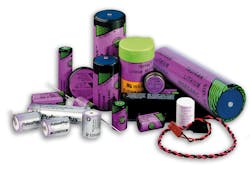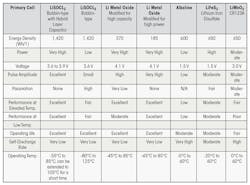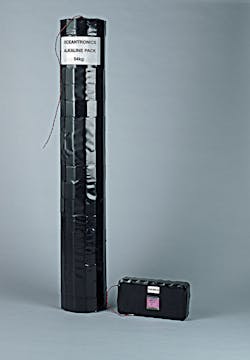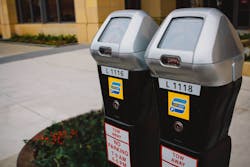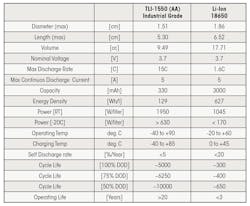In this age of the Industrial Internet of Things (IIoT), battery-powered remote wireless devices are proliferating, bringing low-cost connectivity to industrial applications such as asset tracking, system control, data automation (SCADA), AMR/AMI, metering, AI, machine learning and environmental monitoring, to name a few.
Numerous primary (non-rechargeable) batteries are commercially available that offer unique performance characteristics are commercially. These include alkaline, iron disulfate (LiFeS2), lithium manganese dioxide (LiMNO2) and lithium thionyl chloride (LiSOCl2).
To extend the battery life, low-power remote wireless devices draw only microamps of current and spend the vast majority of time in an energy-conserving “standby” mode. As devices become more miniaturized, challenges arise; smaller cells contain less-active ingredients, thus reducing their nominal capacity.
If the required battery life is relatively short (5-10 years) and the application involves moderate temperatures, then many primary battery chemistries can be considered. However, if the application requires extended battery life (10-plus years) or the deployment involves extreme temperatures, the choice of battery chemistry narrows down considerably. For example, consumer-grade alkaline and lithium batteries can exhibit reduced voltage under pulse load along with accelerated battery self-discharge.
Think Small and Durable
One common mistake is to specify batteries that are too large and contain unneeded capacity to have an extended life. This carries hidden costs, including the expense of transporting these oversized batteries to remote, hard-to-access locations. Plus, the labor and logistical expenses can outweigh the cost of the battery itself. Increasingly restrictive UN and IATA shipping regulations further magnify the hidden expenses.
Utility line crews installing line fault sensors on utility poles across the desert prefer compact, lightweight, long-life batteries that offer extended battery operating life to reduce long-term maintenance costs.
Smaller is generally better. However, it is unwise to specify undersized batteries that lack enough capacity just to satisfy the sole goal of keeping the final device small. This compromise could result in unnecessary battery replacements, leading to a higher cost of ownership.
Exposure to extreme temperatures has a greater effect on batteries with limited temperature ranges. In such cases, oversized batteries may be needed to compensate for expected voltage drops under pulsed loads.
Ultra-long-life, bobbin-type LiSOCl2 batteries feature extremely high capacities and energy densities. They can deliver high pulses at extreme temperatures, thus eliminating the need for the extra capacity or voltage.
These batteries are overwhelmingly preferred for long-term deployments. For example, structural stress sensors mounted on bridge trusses find them almost a necessity. In such applications, replacing batteries consumes significant time and expense to construct protective netting and purchase safety harnesses.
Bobbin-type LiSOCl2 cells can be modified to handle extreme temperatures. For instance, they are well-suited for monitoring the transport of refrigerated goods. An uninterrupted data stream is required to track the transport of frozen food, tissue samples, organs, drugs and pharmaceuticals at −80°C.
The LiSOCl2 cells withstand extreme heat, making them ideal for use in automotive toll tags that are exposed to extreme hot and cold and cycling between them. These batteries are also used in RFID asset tracking devices that monitor the location and status of medical equipment throughout hospitals. These batteries survive autoclave sterilization at temperatures up to 125°C without having to be removed from the medical devices.
Bobbin-type LiSOCl2 batteries rely on carefully controlled passivation by a thin film of lithium that halts chemical reactions. It greatly reduces annual self-discharge. Properly harnessing this passivation effect reduces self-discharge to a point where smaller power supplies can be use and can eliminate the need for future battery replacements.
Controlled passivation is accomplished through proprietary manufacturing methods with high-quality raw materials. For example, superior-grade, bobbin-type LiSOCl2 batteries can have a self-discharge rate as low as 0.7% per year, retaining more than 70% of their original capacity after 40 years. By contrast, lesser-grade LiSOCL2 batteries can have self-discharge rates as high as 3% per year. This means the battery loses 30% of its original capacity every 10 years, making a 40-year battery life impossible.
The Need for High Pulses
Remote wireless devices increasingly need high pulses to power advanced two-way communications. A prime example is an AMR/AMI utility meter transmitter unit (MTU). They are often buried or on buildings exteriors and exposed to the weather.
Consumer alkaline batteries will deliver the high pulses needed for AMR/AMI metering due to their high rate design. However, they are ill suited for use in MTUs because of their low voltage (1.5 V), limited temperature range (−0°C to 60°C), high self-discharge rates, and limited life expectancy (1-2 years). Having to change thousands of AMR/AMI meter batteries every few years would be prohibitively expensive and would compromise data integrity.
Standard bobbin-type LiSOCl2 batteries deliver the exceptional long-life required by AMR/AMI applications. However, they cannot deliver periodic high pulses, as they can experience a temporary drop in voltage when first subjected to this type of pulsed load, a phenomenon known as transient minimum voltage (TMV). To overcome this, the LiSOCl2 battery is paired with a patented Hybrid Layer Capacitor (HLC). The battery and HLC work in parallel, with the standard cell delivering background current (3.6 to 3.9 V nominal range), while the single-unit HLC works like a rechargeable battery to generate periodic high pulses. In addition, the HLC has a unique end-of-life performance curve that can be used to generate “low-battery” alerts.
Supercapacitors are popular for consumer products that need high pulses. However, they have several drawbacks that rule them out for industrial applications including bulkiness, high self-discharge rates of up to 60% per year and limited temperature range. Using several supercapacitors also requires balancing circuits that draw energy (higher self-discharge) and add expense.
Remote wireless applications that draw only milliamps of energy, but enough to prematurely exhaust a primary battery, may be ideal for some form of energy harvesting devices when paired with a rechargeable lithium-ion battery to store the harvested energy. However, consumer-grade rechargeable lithium-ion batteries cannot be used in certain industrial applications due to their limited temperature range and an inability to deliver the high pulses required for two-way wireless communications. Consumer grade rechargeable Li-ion batteries also have limited lifespans of approximately three years and 300 full recharge cycles.
If the wireless device needs to operate beyond 300 recharge cycles without battery replacement, extra cells may be required to reduce the average depth of discharge per cell. Fortunately, an industrial grade rechargeable Li-ion battery is available with up to a 20-year life and up to 5,000 full recharge cycles. These ruggedized cells feature an extended temperature range of −40°C to 85°C, and deliver the high pulses needed to support advanced two-way communications.
Long-life industrial grade primary and rechargeable lithium batteries deliver the extended life, temperature range and high pulse capabilities needed to cost-effectively connect remote wireless devices to the fast-growing IIoT.
Sol Jacobs is VP and general manager for Tadiran Batteries.
About the Author
Sol Jacobs
VP & General Manager
Sol Jacobs, VP and General Manager for Tadiran Batteries, has over 30 years of experience in powering remote devices. His educational background includes a BS in Engineering and an MBA.
